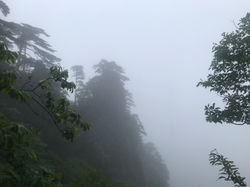Kaohsiung Tenement Tour | 左營古厝散策(1/2)
- Chi Hsu

- 2020年8月13日
- 讀畢需時 4 分鐘
已更新:2024年6月20日
吉客鏈:先民生活史 X 保存歷史現場
New York's Popular Walking Tour
In Manhattan's downtown, there is a very popular walking tour - neither the Wall Street, nor the World Trade Center - it's the Tenement apartment tour.
(Photo Credit | Chi Hsu)
Richard and I took the tour in April, 2018. I wasn't sure what to expect because of my limited knowledge of American migration history. The place we visited was The Lower East Side Tenement Museum is an American National Historical Site authorised on Nov. 12, 1998. After this educational tour, I learned how the immigrants (Irish people) survived in the Big Apple - New York in their early years. (For more info refers to 在美國的愛爾蘭後裔). It was a new perspective on American history.
Kaohsiung's Tenement House Tour
This year, during the long weekends of the Dragon Boat Festival, I was back my hometown to visit my parents. On 28th June, I and my friend Owen visited Kaohsiung Old House Association and met its professional guide, Mr. Kuo.
(Photo Credit | Chi Hsu & KHS Old House Association)
Mr. Kuo gave us an in-depth walking tour of the hidden block with a mass of old houses behind the office of Kaohsiung Old House Association. During his guide, I recalled the memories of my granny's house, not far from the walking tour area. It seemed to walk into a time tunnel and connect with my grandparents' living environment and the community of early 20th century.
(Photo Credit | KHS Old House Association & Chi Hsu)
I suddenly sensed I was on another type of 'Tenement Tour'.
Not in the downtown of Manhattan, New York, but in Tsoying, Kaohsiung.
Not in a vertically multi-level building, but in a horizontally mass of very high density of old houses.
Not in any overseas city but in my hometown where I left since the age of 20.
(Photo Credit | KHS Old House Association & Chi Hsu)
It felt familiar but also looked like an outsider with the living environment. I started to wonder how to support these (great) grandpa and granny's houses whom were the emigrants from mainland China before Chinese Civil War. They are located close to the Walled City and the Kaohsiung's other well-known landmark - the Lotus Pond. (My earlier travelogues mentioned Old FongShan City - Lotus Pond, and Old FongShan City - The First Stone Walled City in Taiwan )
The Walled City and The Early Settlement
These houses, inhabited by ordinary people, seem very critical to the story of Kaohsiung's Walled City. They make the whole piece of historical place making more lively. A history won't be inspiring without the people's story. I attempted to learn more about how these old houses in related with the walled city.
Kaohsiung's Culture Bureau organized a series of historical and archeological research workshops for the public. I was very interested and attended two and the speakers in both cases was Dr. Chen. His insightful slides provided me with the structural information of historical place making from an academical point of view.
(Photo Credit | Chi Hsu)
During the Qing era, according to the findings of Dr. Chen's research, there were only governors and officers' buildings inside of the walled city as well as religious temples and shrines. Ordinary residents lived outside of north gate of the wall with marketplaces were also clustered nearby.
The reason people settled in the north of the wall was to access northwards the capital city - Tainan - located to the north. Using google map's estimate, it takes 2.5 hrs from Fongshan walled city to Zeelandia (the fort in the old capital walled city of Tainan). (see Google maps below)
Also, the Lotus Pond became the well-known attraction of the city was always there for agriculture usage. (see the middle snapshot below) Dr. Chen's team generated various maps of the current buildings' status. In the right map below, the red colored represents the brick old houses of Minnan style which date back to the Qing and Japanese rule era.
(Left map source: Google | Mid and Right map snapshots: Dr. Chen's research)
Backdated nearly 300 years, the early settlements seemed to select a very good feng-sui location for living but they had a rough and unplanned expansion, then became disordered streetscapes. Modern urban regeneration plans skipped these old houses lived in by the poorer.
In general, these streetscapes called "Seven Baojia Alleys". [Note1: Baojia]
KHS Old House Association was established by the private sector, to promote and to record the highest density old houses which still existed in Taiwan. Showcasing the ordinary people's story and lifestyle of Fongshan (Old) Walled City - the First Stone Walled City of Taiwan.
Last weekend, I thought I would try to absorb all the information sensationally so I took a walk and had a coffee around the North Gate of the wall. (The North Gate is under renovation.)
(Photo Credit | Chi Hsu)
I noticed that some of the walls and the houses were very closely attached as Dr. Chen's presentations mentioned. I believe the way our ancestors lived should be preserved and demonstrated for future Taiwanese generations and overseas tourists. Just like the NYC's Tenement Museum set up for American national historical site.
My next blog will show how the walled city and the old houses related to the Lotus Pond. (to be continued > click here for Part 2.)
[Note 1] (Source: Wiki) Baojia was a system of administrative control derived from the Qing regime, which extended to Taiwan in 1733. The institution was created in the context of frequent rebellions in the mid-nineteenth century rebellions and its purpose was to maintain local stability. The baojia would effectively internally police through group responsibility. The system monitored the rural community at three levels; the bao, referring to the 10 household unit, the 100 household unit and the 1000 household unit respectively.

















































留言